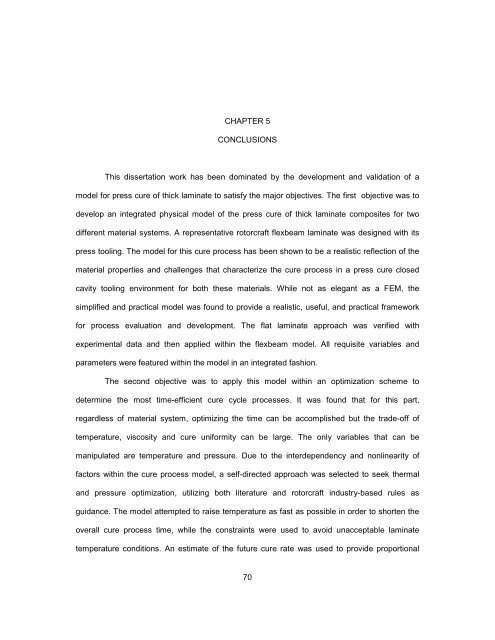TOOLED THICK COMPOSITES by ARVEN H. SAUNDERS III ...
TOOLED THICK COMPOSITES by ARVEN H. SAUNDERS III ...
TOOLED THICK COMPOSITES by ARVEN H. SAUNDERS III ...
Create successful ePaper yourself
Turn your PDF publications into a flip-book with our unique Google optimized e-Paper software.
CHAPTER 5<br />
CONCLUSIONS<br />
This dissertation work has been dominated <strong>by</strong> the development and validation of a<br />
model for press cure of thick laminate to satisfy the major objectives. The first objective was to<br />
develop an integrated physical model of the press cure of thick laminate composites for two<br />
different material systems. A representative rotorcraft flexbeam laminate was designed with its<br />
press tooling. The model for this cure process has been shown to be a realistic reflection of the<br />
material properties and challenges that characterize the cure process in a press cure closed<br />
cavity tooling environment for both these materials. While not as elegant as a FEM, the<br />
simplified and practical model was found to provide a realistic, useful, and practical framework<br />
for process evaluation and development. The flat laminate approach was verified with<br />
experimental data and then applied within the flexbeam model. All requisite variables and<br />
parameters were featured within the model in an integrated fashion.<br />
The second objective was to apply this model within an optimization scheme to<br />
determine the most time-efficient cure cycle processes. It was found that for this part,<br />
regardless of material system, optimizing the time can be accomplished but the trade-off of<br />
temperature, viscosity and cure uniformity can be large. The only variables that can be<br />
manipulated are temperature and pressure. Due to the interdependency and nonlinearity of<br />
factors within the cure process model, a self-directed approach was selected to seek thermal<br />
and pressure optimization, utilizing both literature and rotorcraft industry-based rules as<br />
guidance. The model attempted to raise temperature as fast as possible in order to shorten the<br />
overall cure process time, while the constraints were used to avoid unacceptable laminate<br />
temperature conditions. An estimate of the future cure rate was used to provide proportional<br />
70
















